Guanfeng Liu
Towards Comprehensive and Prerequisite-Free Explainer for Graph Neural Networks
May 20, 2025Abstract:To enhance the reliability and credibility of graph neural networks (GNNs) and improve the transparency of their decision logic, a new field of explainability of GNNs (XGNN) has emerged. However, two major limitations severely degrade the performance and hinder the generalizability of existing XGNN methods: they (a) fail to capture the complete decision logic of GNNs across diverse distributions in the entire dataset's sample space, and (b) impose strict prerequisites on edge properties and GNN internal accessibility. To address these limitations, we propose OPEN, a novel c\textbf{O}mprehensive and \textbf{P}rerequisite-free \textbf{E}xplainer for G\textbf{N}Ns. OPEN, as the first work in the literature, can infer and partition the entire dataset's sample space into multiple environments, each containing graphs that follow a distinct distribution. OPEN further learns the decision logic of GNNs across different distributions by sampling subgraphs from each environment and analyzing their predictions, thus eliminating the need for strict prerequisites. Experimental results demonstrate that OPEN captures nearly complete decision logic of GNNs, outperforms state-of-the-art methods in fidelity while maintaining similar efficiency, and enhances robustness in real-world scenarios.
Adaptive Graph Unlearning
May 19, 2025Abstract:Graph unlearning, which deletes graph elements such as nodes and edges from trained graph neural networks (GNNs), is crucial for real-world applications where graph data may contain outdated, inaccurate, or privacy-sensitive information. However, existing methods often suffer from (1) incomplete or over unlearning due to neglecting the distinct objectives of different unlearning tasks, and (2) inaccurate identification of neighbors affected by deleted elements across various GNN architectures. To address these limitations, we propose AGU, a novel Adaptive Graph Unlearning framework that flexibly adapts to diverse unlearning tasks and GNN architectures. AGU ensures the complete forgetting of deleted elements while preserving the integrity of the remaining graph. It also accurately identifies affected neighbors for each GNN architecture and prioritizes important ones to enhance unlearning performance. Extensive experiments on seven real-world graphs demonstrate that AGU outperforms existing methods in terms of effectiveness, efficiency, and unlearning capability.
Behavior Pattern Mining-based Multi-Behavior Recommendation
Aug 22, 2024Abstract:Multi-behavior recommendation systems enhance effectiveness by leveraging auxiliary behaviors (such as page views and favorites) to address the limitations of traditional models that depend solely on sparse target behaviors like purchases. Existing approaches to multi-behavior recommendations typically follow one of two strategies: some derive initial node representations from individual behavior subgraphs before integrating them for a comprehensive profile, while others interpret multi-behavior data as a heterogeneous graph, applying graph neural networks to achieve a unified node representation. However, these methods do not adequately explore the intricate patterns of behavior among users and items. To bridge this gap, we introduce a novel algorithm called Behavior Pattern mining-based Multi-behavior Recommendation (BPMR). Our method extensively investigates the diverse interaction patterns between users and items, utilizing these patterns as features for making recommendations. We employ a Bayesian approach to streamline the recommendation process, effectively circumventing the challenges posed by graph neural network algorithms, such as the inability to accurately capture user preferences due to over-smoothing. Our experimental evaluation on three real-world datasets demonstrates that BPMR significantly outperforms existing state-of-the-art algorithms, showing an average improvement of 268.29% in Recall@10 and 248.02% in NDCG@10 metrics. The code of our BPMR is openly accessible for use and further research at https://github.com/rookitkitlee/BPMR.
Few-shot Learning on Heterogeneous Graphs: Challenges, Progress, and Prospects
Mar 10, 2024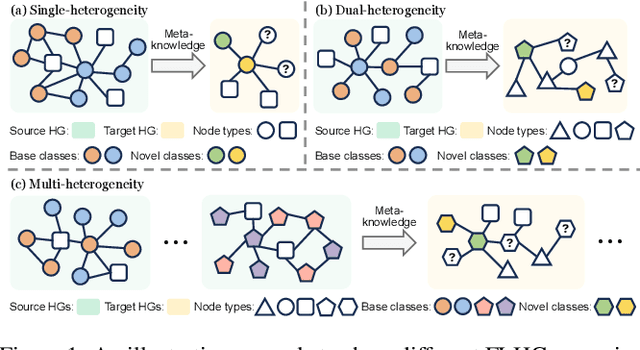
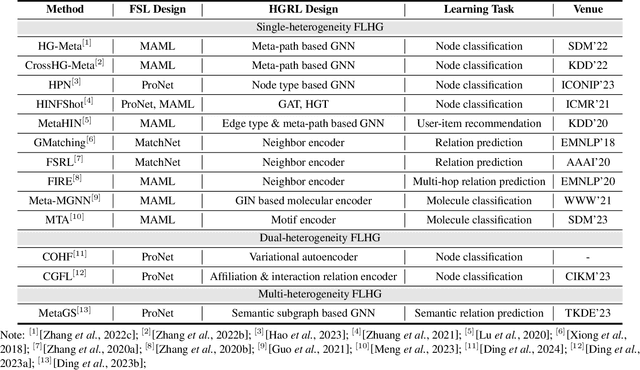
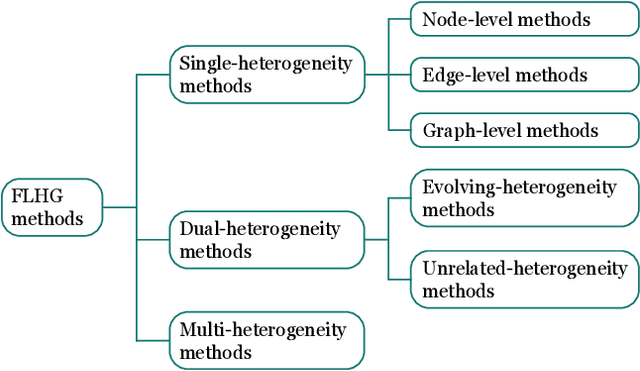
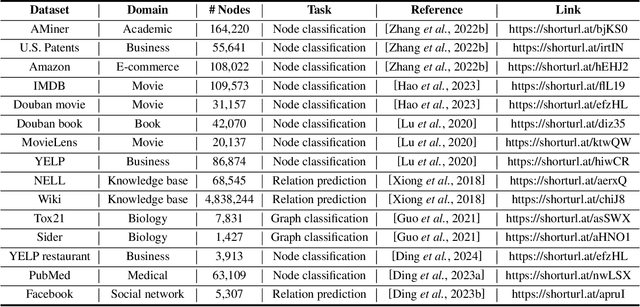
Abstract:Few-shot learning on heterogeneous graphs (FLHG) is attracting more attention from both academia and industry because prevailing studies on heterogeneous graphs often suffer from label sparsity. FLHG aims to tackle the performance degradation in the face of limited annotated data and there have been numerous recent studies proposing various methods and applications. In this paper, we provide a comprehensive review of existing FLHG methods, covering challenges, research progress, and future prospects. Specifically, we first formalize FLHG and categorize its methods into three types: single-heterogeneity FLHG, dual-heterogeneity FLHG, and multi-heterogeneity FLHG. Then, we analyze the research progress within each category, highlighting the most recent and representative developments. Finally, we identify and discuss promising directions for future research in FLHG. To the best of our knowledge, this paper is the first systematic and comprehensive review of FLHG.
Adaptive Hypergraph Network for Trust Prediction
Feb 07, 2024Abstract:Trust plays an essential role in an individual's decision-making. Traditional trust prediction models rely on pairwise correlations to infer potential relationships between users. However, in the real world, interactions between users are usually complicated rather than pairwise only. Hypergraphs offer a flexible approach to modeling these complex high-order correlations (not just pairwise connections), since hypergraphs can leverage hyperedeges to link more than two nodes. However, most hypergraph-based methods are generic and cannot be well applied to the trust prediction task. In this paper, we propose an Adaptive Hypergraph Network for Trust Prediction (AHNTP), a novel approach that improves trust prediction accuracy by using higher-order correlations. AHNTP utilizes Motif-based PageRank to capture high-order social influence information. In addition, it constructs hypergroups from both node-level and structure-level attributes to incorporate complex correlation information. Furthermore, AHNTP leverages adaptive hypergraph Graph Convolutional Network (GCN) layers and multilayer perceptrons (MLPs) to generate comprehensive user embeddings, facilitating trust relationship prediction. To enhance model generalization and robustness, we introduce a novel supervised contrastive learning loss for optimization. Extensive experiments demonstrate the superiority of our model over the state-of-the-art approaches in terms of trust prediction accuracy. The source code of this work can be accessed via https://github.com/Sherry-XU1995/AHNTP.
Few-Shot Causal Representation Learning for Out-of-Distribution Generalization on Heterogeneous Graphs
Jan 07, 2024Abstract:Heterogeneous graph few-shot learning (HGFL) has been developed to address the label sparsity issue in heterogeneous graphs (HGs), which consist of various types of nodes and edges. The core concept of HGFL is to extract knowledge from rich-labeled classes in a source HG, transfer this knowledge to a target HG to facilitate learning new classes with few-labeled training data, and finally make predictions on unlabeled testing data. Existing methods typically assume that the source HG, training data, and testing data all share the same distribution. However, in practice, distribution shifts among these three types of data are inevitable due to two reasons: (1) the limited availability of the source HG that matches the target HG distribution, and (2) the unpredictable data generation mechanism of the target HG. Such distribution shifts result in ineffective knowledge transfer and poor learning performance in existing methods, thereby leading to a novel problem of out-of-distribution (OOD) generalization in HGFL. To address this challenging problem, we propose a novel Causal OOD Heterogeneous graph Few-shot learning model, namely COHF. In COHF, we first characterize distribution shifts in HGs with a structural causal model, establishing an invariance principle for OOD generalization in HGFL. Then, following this invariance principle, we propose a new variational autoencoder-based heterogeneous graph neural network to mitigate the impact of distribution shifts. Finally, by integrating this network with a novel meta-learning framework, COHF effectively transfers knowledge to the target HG to predict new classes with few-labeled data. Extensive experiments on seven real-world datasets have demonstrated the superior performance of COHF over the state-of-the-art methods.
Intent Contrastive Learning with Cross Subsequences for Sequential Recommendation
Oct 31, 2023
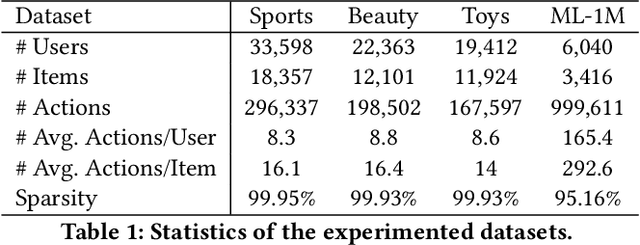

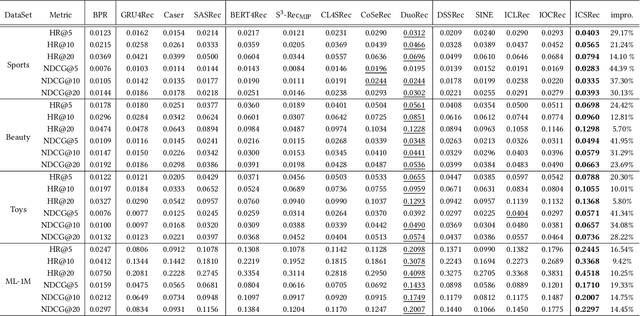
Abstract:The user purchase behaviors are mainly influenced by their intentions (e.g., buying clothes for decoration, buying brushes for painting, etc.). Modeling a user's latent intention can significantly improve the performance of recommendations. Previous works model users' intentions by considering the predefined label in auxiliary information or introducing stochastic data augmentation to learn purposes in the latent space. However, the auxiliary information is sparse and not always available for recommender systems, and introducing stochastic data augmentation may introduce noise and thus change the intentions hidden in the sequence. Therefore, leveraging user intentions for sequential recommendation (SR) can be challenging because they are frequently varied and unobserved. In this paper, Intent contrastive learning with Cross Subsequences for sequential Recommendation (ICSRec) is proposed to model users' latent intentions. Specifically, ICSRec first segments a user's sequential behaviors into multiple subsequences by using a dynamic sliding operation and takes these subsequences into the encoder to generate the representations for the user's intentions. To tackle the problem of no explicit labels for purposes, ICSRec assumes different subsequences with the same target item may represent the same intention and proposes a coarse-grain intent contrastive learning to push these subsequences closer. Then, fine-grain intent contrastive learning is mentioned to capture the fine-grain intentions of subsequences in sequential behaviors. Extensive experiments conducted on four real-world datasets demonstrate the superior performance of the proposed ICSRec model compared with baseline methods.
Meta-optimized Joint Generative and Contrastive Learning for Sequential Recommendation
Oct 21, 2023Abstract:Sequential Recommendation (SR) has received increasing attention due to its ability to capture user dynamic preferences. Recently, Contrastive Learning (CL) provides an effective approach for sequential recommendation by learning invariance from different views of an input. However, most existing data or model augmentation methods may destroy semantic sequential interaction characteristics and often rely on the hand-crafted property of their contrastive view-generation strategies. In this paper, we propose a Meta-optimized Seq2Seq Generator and Contrastive Learning (Meta-SGCL) for sequential recommendation, which applies the meta-optimized two-step training strategy to adaptive generate contrastive views. Specifically, Meta-SGCL first introduces a simple yet effective augmentation method called Sequence-to-Sequence (Seq2Seq) generator, which treats the Variational AutoEncoders (VAE) as the view generator and can constitute contrastive views while preserving the original sequence's semantics. Next, the model employs a meta-optimized two-step training strategy, which aims to adaptively generate contrastive views without relying on manually designed view-generation techniques. Finally, we evaluate our proposed method Meta-SGCL using three public real-world datasets. Compared with the state-of-the-art methods, our experimental results demonstrate the effectiveness of our model and the code is available.
Cross-heterogeneity Graph Few-shot Learning
Aug 10, 2023Abstract:In recent years, heterogeneous graph few-shot learning has been proposed to address the label sparsity issue in heterogeneous graphs (HGs), which contain various types of nodes and edges. The existing methods have achieved good performance by transferring generalized knowledge extracted from rich-labeled classes in source HG(s) to few-labeled classes in a target HG. However, these methods only consider the single-heterogeneity scenario where the source and target HGs share a fixed set of node/edge types, ignoring the more general scenario of cross-heterogeneity, where each HG can have a different and non-fixed set of node/edge types. To this end, we focus on the unexplored cross-heterogeneity scenario and propose a novel model for Cross-heterogeneity Graph Few-shot Learning, namely CGFL. In CGFL, we first extract meta-patterns to capture heterogeneous information and propose a multi-view heterogeneous graph neural network (MHGN) to learn meta-patterns across HGs. Then, we propose a score module to measure the informativeness of labeled samples and determine the transferability of each source HG. Finally, by integrating MHGN and the score module into a meta-learning mechanism, CGFL can effectively transfer generalized knowledge to predict new classes with few-labeled data. Extensive experiments on four real-world datasets have demonstrated the superior performance of CGFL over the state-of-the-art methods.
Snowman: A Million-scale Chinese Commonsense Knowledge Graph Distilled from Foundation Model
Jun 17, 2023Abstract:Constructing commonsense knowledge graphs (CKGs) has attracted wide research attention due to its significant importance in cognitive intelligence. Nevertheless, existing CKGs are typically oriented to English, limiting the research in non-English languages. Meanwhile, the emergence of foundation models like ChatGPT and GPT-4 has shown promising intelligence with the help of reinforcement learning from human feedback. Under the background, in this paper, we utilize foundation models to construct a Chinese CKG, named Snowman. Specifically, we distill different types of commonsense head items from ChatGPT, and continue to use it to collect tail items with respect to the head items and pre-defined relations. Based on the preliminary analysis, we find the negative commonsense knowledge distilled by ChatGPT achieves lower human acceptance compared to other knowledge. Therefore, we design a simple yet effective self-instruct filtering strategy to filter out invalid negative commonsense. Overall, the constructed Snowman covers more than ten million Chinese commonsense triples, making it the largest Chinese CKG. Moreover, human studies show the acceptance of Snowman achieves 90.6\%, indicating the high-quality triples distilled by the cutting-edge foundation model. We also conduct experiments on commonsense knowledge models to show the usability and effectiveness of our Snowman.
 Add to Chrome
Add to Chrome Add to Firefox
Add to Firefox Add to Edge
Add to Edge